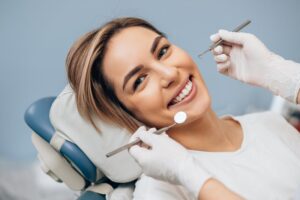
The desire for a beautiful smile is hardly a modern phenomenon. Long before the safe and effective cosmetic dental methods used today, many ancient and medieval cultures had a somewhat bizarre way to achieve an aesthetically pleasing set of teeth. By the end, you may even be glad about how easy the treatments are today! Continue reading to take a peek into the past and explore how cosmetic dentistry has evolved.
Ancient Methods of Cosmetic Dentistry
As far back as 700 B.C., there is evidence of a group of people wanting to fill gaps in their smiles. The Etruscans would make dentures out of ivory and bone, sometimes using teeth from deceased humans and animals!
Ancient Egyptians were also dabbling in the art of cosmetic dentistry. To replace missing teeth, they would hammer seashells into their gums. Additionally, they would make dental crowns and bridges from gold and create toothpaste out of pumice and vinegar to remove dental stains.
One of the most surprising methods from this time comes from the Ancient Romans. To remove discoloration from their teeth, they would use their own urine! The shocking part is that it surprisingly works. Ammonium in urine is effective in breaking up stains, but it’s not the most desirable solution.
Cosmetic Dentistry During Medieval Times
As you move down the timeline, the Middle Ages also had some unexpected cosmetic dentistry history. Instead of going to two places for a haircut and dental work, people would just visit their barber, as it was part of their job! Their teeth whitening process involved filing down the stained tooth and coating it with acid. However, doing so would destroy the enamel and the tooth itself.
Medieval Europeans decided to bring back the lost art of replacing teeth with ivory and bone. Like the Etruscans, they would make dentures and take the teeth from deceased humans, but there wasn’t much success.
The Rise of Modern Cosmetic Dentistry
It wasn’t until the 1700s that cosmetic dentistry started to improve drastically. Some of the first practices included using porcelain for dentures and a plaster mold to ensure the prosthetic fits better. As early as the 1900s, the material for dentures was changed to plastic and acrylic. In fact, acrylic is still used for dentures today!
In 1989, teeth whitening took a huge leap forward with the discovery of carbamide peroxide as a bleaching agent. This method was a much gentler process. Just a few years later in the 20th century, other ways to get a perfect smile emerged.
Dental veneers began in the 1930s to temporarily fix film stars’ teeth, but they would come off after a short time. New techniques in the 1980s allowed for the cosmetic to bond more effectively and become longer lasting. Now, modern veneers are both thin and durable, even lasting for over a decade with proper care.
Cosmetic dentistry has come a very long way. Modern methods are designed with your comfort and safety in mind. These treatments are more effective than they were before, so you can be grateful that past ancient and medieval approaches have been retired!
About the Author
Dr. Annie Yu earned her Doctor of Dental Surgery from The Ohio State University College of Dentistry. She believes in continuing her education by staying up to date with modern techniques and technology. Dr. Yu is a proud member of the American Academy of Cosmetic Dentistry, so you can trust you’re in expert care no matter what cosmetic dental treatment service you choose. If you want to enhance your smile, schedule an appointment or call us at (240) 743-4421.
